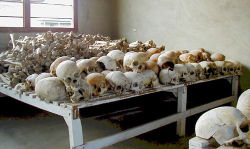- Dark tourism
-
 Murambi Technical School where many of the murders in the Rwandan genocide took place is now a genocide museum.
Murambi Technical School where many of the murders in the Rwandan genocide took place is now a genocide museum.
Dark tourism (also black tourism or grief tourism) is tourism involving travel to sites associated with death and suffering. Thanatourism,[1] derived from the Ancient Greek word thanatos for the personification of death, is associated with dark tourism but refers more specifically to violent death; it is used in fewer contexts than the terms dark tourism, grief tourism, and quite tourism. The main draw however to these locations is mostly due to their historical value rather than their associations with death and suffering.[2]
This includes castles and battlefields such as Culloden in Scotland and Bran Castle and Poienari Castle in Romania; sites of disaster, either natural or man made, such as Hiroshima in Japan, Chernobyl in Ukraine and the Ground Zero in New York; Auschwitz in Poland; prisons now open to the public such as Beaumaris Prison in Anglesey, Wales; and purpose built centers such as the London Dungeon. A notable example is how tourism to Detroit is sometimes geared towards looking at the fall of the former glamor instead of what it has managed to retain. It also includes other sites of human attrocities and genocide, such as the Nanjing Massacre Memorial Hall in Nanjing and the Tuol Sleng Genocide Museum in Cambodia.
See also
Notes
- ^ Heritage, Museums and Galleries: An Introductory Reader, by Gerard Corsane, 2005. Page 266
- ^ http://www.gonomad.com/features/0704/dark-tourism.html
--90.213.124.167 (talk) 19:17, 11 November 2011 (UTC)s.duncans.duncan
External links
- "What is dark tourism?", The Guardian special feature
- Dark Tourism Forum
- Grief tourism blog
- Dark Tourism Ideas in Latin America
- Chernobyl: Unlikely Tourist Spot - slideshow by Life magazine
- Places of interest along Hitlers Atlantic Wall in Denmark and Norway
Categories:- Types of tourism
- Grief
- Cultural aspects of death
Wikimedia Foundation. 2010.
